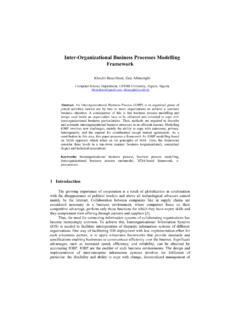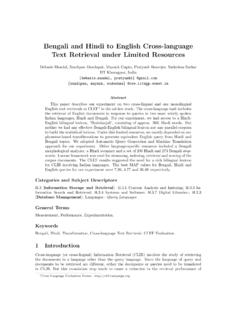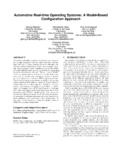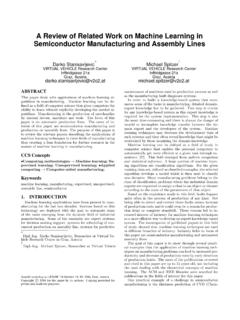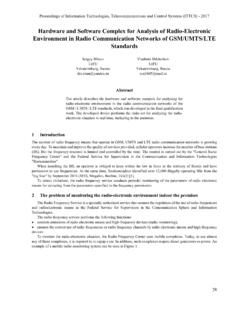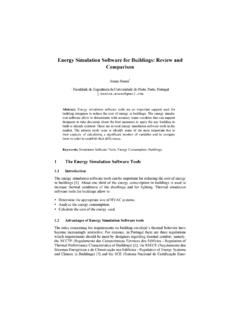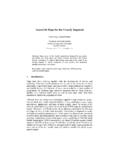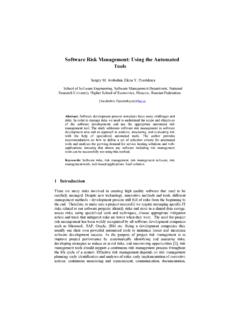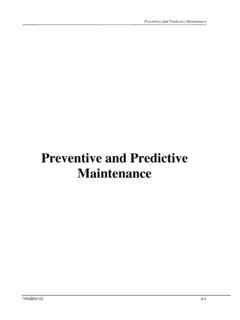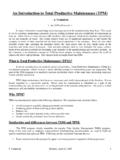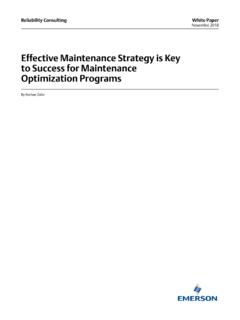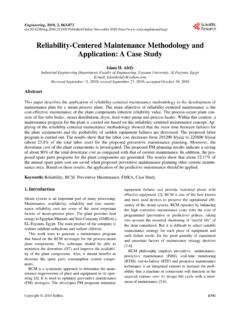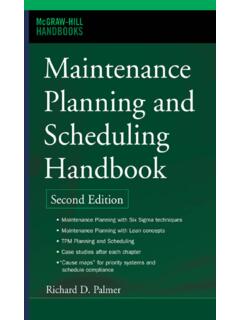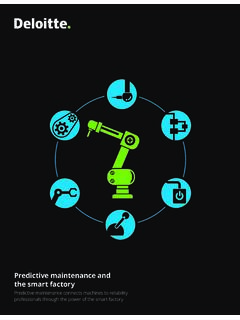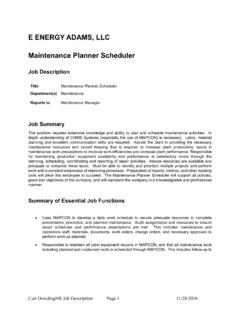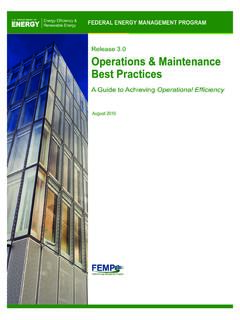Transcription of Early Failure Detection for Predictive Maintenance of ...
1 Early Failure Detection for Predictive Maintenance of Sensor PartsTom Kuzin, Tom Borovi ckaFaculty of Information Technology,Czech Technical University in Prague,Prague, The Czech Repubic t t t ,t s r t t Abstract: Maintenance of a sensor part typically meansrenewal of the sensor in regular intervals or replacing themalfunctioning sensor. However optimal timing of the re-placement can reduce Maintenance costs. The aim of thisarticle is to suggest a Predictive Maintenance strategy forsensors using condition monitoring and Early Failure de-tection based on their own collected different approaches that deal with Early failuredetection of sensor parts are introduced 1) approach basedon feature extraction and status classification, 2) approachbased on time series modeling and 3) approach based onanomaly Detection using autoencoders.
2 All methods wereillustrated on real-world data and were proven to be appli-cable for condition IntroductionIn the last decade the amount of used sensors across allsectors has significantly raised. This is important and astill continuing the classical concept, Predictive Maintenance takesplace when the maintained asset is expensive or importantfor key business processes. In other words when properutilization of the machinery has important economic orsafety consequences. This is not the characteristic caseof sensor parts which are usually cheap and play a minorrole. For such assets Maintenance typically means sim-ple replacement and reactive Maintenance strategy wouldbe the most common choice.
3 However, machines becomemore and more dependent on sensor parts and that bringsnew challenges in their Maintenance . Proper timing of re-placement has direct influence on Maintenance in cases where other processes depend on thesensor readings and the sensor Failure or malfunction maystop the operation or cause collateral loses of a case of sensors "classical" condition monitoringscheme utilizing properly chosen set of external sensorsmakes no sense. On the other hand sensors themselvesprovide on-line measurements during their whole opera-tional service. These data may be exploited to estimate thecurrent state of the measuring device. Therefore applyingsmarter Maintenance strategy for sensor parts makes per-fect sense and may introduce significant article deals with the possibilities of smarter main-tenance strategies for sensor parts.
4 The main idea is to ap-ply machine learning techniques in order to monitor thecurrent condition or predict Failure of sensors based ontheir own measurements and propose an optimal time fortheir replacement in order to avoid Related WorkSeveral articles and works on "classical" Predictive main-tenance and condition monitoring [1, 2] were published inthe literature. Predictive Maintenance strategy is usuallya rule-based Maintenance grounded on on-line conditionmonitoring, which relies on an appropriately chosen setof external sensors. The proper sensor set plays the keyrole [2]. Unfortunately none of these techniques are usefulif it is needed to monitor the state of sensors , many published works base their approacheson sensor networks, where malfunction of one sensor canbe identified utilizing measurements of other sensors inthe network.
5 However, this paper focuses on "standalone"sensors where no more devices sensing the same or corre-lated phenomena are available. Thus these approaches useonly measurements of the sensor itself. Since there are notmany available publications for this case, further reviewis focused on categorization of faults and fault detectiontechniques of both the sensors and sensor provide a huge amount of information about ob-served phenomena. However, to make meaningful conclu-sions, the quality of the data has to be ensured. Sensorsalone can malfunction and that can distort an image of thephenomena. Most of the methods follow a common frame-work, characterize the normal behavior of sensor readings,identify significant deviations and mark them as case of sensor networks the most frequent types offaults have been described and categorized by Ni, K.
6 Etal[3]. They describe two distinct approaches to deal withfaults. The first is a data-centric view which examines thedata collected by a given sensor and describes fault mod-els based on data features. In contrary there is a system-centric view which examines physical malfunctions of asensor and how those may manifest themselves in the re-sulting data. According to Ni et. al. these two views arerelated to one another and every fault can be mapped be-tween these two. The important fault categories discussedin [3] are summarized in Table 1. In this article the focusis on the data centric point of , et al.[4] loosely follow on the work of Niet al. and propose specific algorithms for fault 2016 Proceedings, CEUR Workshop Proceedings Vol.
7 1649, pp. 123 130 , Series ISSN 1613-0073,c 2016 T. Kuzin, T. Borovi ckaThey focus only on a subset of fault types examined in [3]and summarized in Table 1: Taxonomy of Faults described by Ni et al.[3].Data-centric point of view t t OutlierIsolated data point or sensor unexpect-edly distant from data points with a much greaterthan expected rate of change. Stuck-at Sensor values experience zero variationfor an unexpected length of Noise orVarianceSensor values experience unexpectedlyhigh variation or different classes of approaches for detecting abovementioned faults are Methodsuse domain knowledge to developheuristic constraints that the sensor readings must of those constraints imply faults.
8 For abovementioned fault types following simple rules are typicallyused [4]:The variance (or the standard deviation) of the samplereadings within a window of sizewsizeis computed. Ifit is above a certain threshold, the samples are corruptedby the noise fault. If the variance is zero the samples arecorrupted by the constant fault. In order to detect shortnoise faults, the data had to be appropriately the rate of change is above a threshold, it can be assumedthat the data were affected by short performance of this method strongly depends onparameterswsizeand the threshold. Parameter setting isnot trivial and usually requires domain knowledge of theexamined Methodscan be used when a physi-cal phenomena is sensed concurrently by multiple sensorsand dependence between sensor measurements can be ex-ploited to generate estimates for the individual sensor mea-surements.
9 The dependence can be expressed by spatialcorrelation. Regardless of the cause of the correlation, itcan be used to model the normal behavior. The estima-tion can be done for example by Linear Least-Squares Es-timation. This method is most suitable for cases when thephenomena is sensed by almost identical sensors. As anexample one can imagine multiple barometric altimeterson a single aircraft. In this case there is a strong presump-tion that the values are strongly Methodsutilize the fact, that mea-surements of a sensor are not random and therefore con-tain some kind of regular patterns. This patterns can bedescribed through autocorrelations in measurements col-lected by a single sensor.
10 These can be used to create aregressive model of sensed phenomena. A sensor mea-surement can be than compared against its predicted valueto determine if it is is that this approach is more general thanclassification and can be used even if there are no labeleddata available nor multiple strongly correlated Methodsuse training data to infermodel of "normal" sensor behavior. If the "normal" sen-sor behavior and the effects of sensor faults are well un-derstood, learning-based methods may be suitable to de-tect and classify sensor faults. In [4] authors successfullyuse Hidden Markov Models to construct a model of sen-sor measurements. The main advantage of learning basedmethods is that they can simultaneously detect and ClassificationIn the terminology of machine learning, classification isconsidered an instance of supervised learning, ma-chine learning technique where a training set of correctlyidentified observations is available [5].
